Orientation of Steel Fibers in Magnetically Driven Concrete and Mortar
Abstract
:1. Introduction
2. Steel Fiber Orientation in Magnetically Driven Concrete
2.1. Experimental Investigation
2.2. Test Results
3. Steel Fiber Orientation in Magnetically Driven Mortar
3.1. Experimental Investigation
3.2. Test Results
4. Conclusions
Acknowledgments
Author Contributions
Conflicts of Interest
References
- Naaman, A.E. Engineered steel fibers with optimal properties for reinforcement of cement composites. J. Adv. Concr. Technol. 2003, 1, 241–252. [Google Scholar] [CrossRef]
- Doyon-Barbant, J. Charron, Influence de L’orientation des Fibers sur le Comportement Mécanqiue des BRF; Département des Génies Civil, Géologique et des Mines, Ecole Polytechnique de Montréal: Montréal, QC, Canada, 2016.
- Ferrara, L. Tailoring the orientation of fibres in high performance fibre reinforced cementitious composites: Part 1—Experimental evidence, monitoring and prediction. Int. J. Mater. Struct. Integr. 2015, 9, 72–91. [Google Scholar] [CrossRef]
- Oesterlee, C. Structural Response of Reinforced UHPFRC and RC Composite Members. Ph.D. Thesis, Swiss Federal Institute of Technology in Lausanne, Lausanne, Switzerland, 2010. [Google Scholar]
- Delsol, S.; Charron, J.-P. Numerical modeling of UHPFRC mechanical behavior based on fibre orientation. In Proceedings of the RILEM-fib-AFGC Int. Symposium on Ultra-High Performance Fibre-Reinforced Concrete, UHPFRC 2013, Marseille, France, 1–3 October 2013; pp. 1–11. Available online: http://demo.webdefy.com/rilem-new/wp-content/uploads/2016/10/dd5afe2e8c26f32fc55f884a0007f940.pdf (accessed on 16 January 2018).
- Ferrara, L.; Ozyurt, N.; di Prisco, M. High mechanical performance of fibre reinforced cementitious composites: The role of “casting-flow induced” fibre orientation. Mater. Struct. 2011, 44, 109–128. [Google Scholar] [CrossRef]
- De Oliveira, F.L. Design-oriented constitutive model for steel fiber reinforced concrete. Ph.D. Thesis, Universitat Politecnica de Catalunya. Available online: https://upcommons.upc.edu/bitstream/handle/2117/93486/TFLO1de3.pdf (accessed on 16 January 2018).
- Eik, M.; Puttonen, J.; Herrmann, H. The effect of approximation accuracy of the orientation distribution function on the elastic properties of short fibre reinforced composites. Compos. Struct. 2016, 148, 12–18. [Google Scholar] [CrossRef]
- Plagué, T.; Desmettre, C.; Charron, J.-P. Influence of fiber type and fiber orientation on cracking and permeability of reinforced concrete under tensile loading. Cem. Concr. Res. 2017, 94, 59–70. [Google Scholar] [CrossRef]
- Kang, S.T.; Lee, B.Y.; Kim, J.; Kim, Y.Y. The effect of fibre distribution characteristics on the flexural strength of steel fibre-reinforced ultra high strength concrete. Constr. Build. Mater. 2011, 25, 2450–2457. [Google Scholar] [CrossRef]
- Kang, S.T.; Kim, J. The relation between fiber orientation and tensile behavior in ultra-high performance fiber reinforced cementitious composites (UPFRCC). Cem. Concr. Res. 2011, 41, 1001–1014. [Google Scholar] [CrossRef]
- Wille, K.; Tue, N.V.; Parra-Montesionos, G.J. Fibre distribution and orientation in UHPFRC beams and their effect on backward analysis. Mater. Struct. 2014, 47, 1825–1838. [Google Scholar] [CrossRef]
- Wuest, J.; Denarié, E.; Brühwiler, E.; Tamarit, L.; Kocher, M.; Gallucci, E. Tomography analysis of fiber distribution and orientation in ultra high-performance fiber reinforced composites with high-fiber dosages. Exp. Tech. 2009, 33, 50–55. [Google Scholar] [CrossRef]
- Yoo, D.; Kang, S.; Yoon, Y. Effect of fiber length and placement method on flexural behavior, tension-softening curve and fiber distribution characteristics of UHPFRC. Constr. Build. Mater. 2014, 64, 67–81. [Google Scholar] [CrossRef]
- Bastien-Masse, M.; Denarié, E.; Brühwiler, E. Effect of fiber orientation on the in-plane tensile response of UHPFRC reinforcement layers. Cem. Concr. Compos. 2016, 62, 111–125. [Google Scholar] [CrossRef]
- Švec, O.; Zirgulis, G.; Bolander, J.E.; Stang, H. Influence of formwork surface on the orientation of steel fibres within self-compacting concrete and on the mechanical properties of cast structural elements. Cem. Concr. Compos. 2014, 50, 60–72. [Google Scholar] [CrossRef]
- Abrishambaf, A.; Pimentel, M.; Nunes, S. Influence of fibre orientation on the tensile behaviour of ultra-high performance fibre reinforced cementitious composites. Cem. Concr. Res. 2017, 97, 28–40. [Google Scholar] [CrossRef]
- Chen, J.; Wang, J.; Jin, W.L. Study of magnetically driven concrete. Constr. Build. Mater. 2016, 121, 53–59. [Google Scholar] [CrossRef]
- GB50936-2014. Technical Code for Concrete-Filled Steel Tubular Structures; Ministry of Urban and Rural Construction: Beijing, China, 2014.

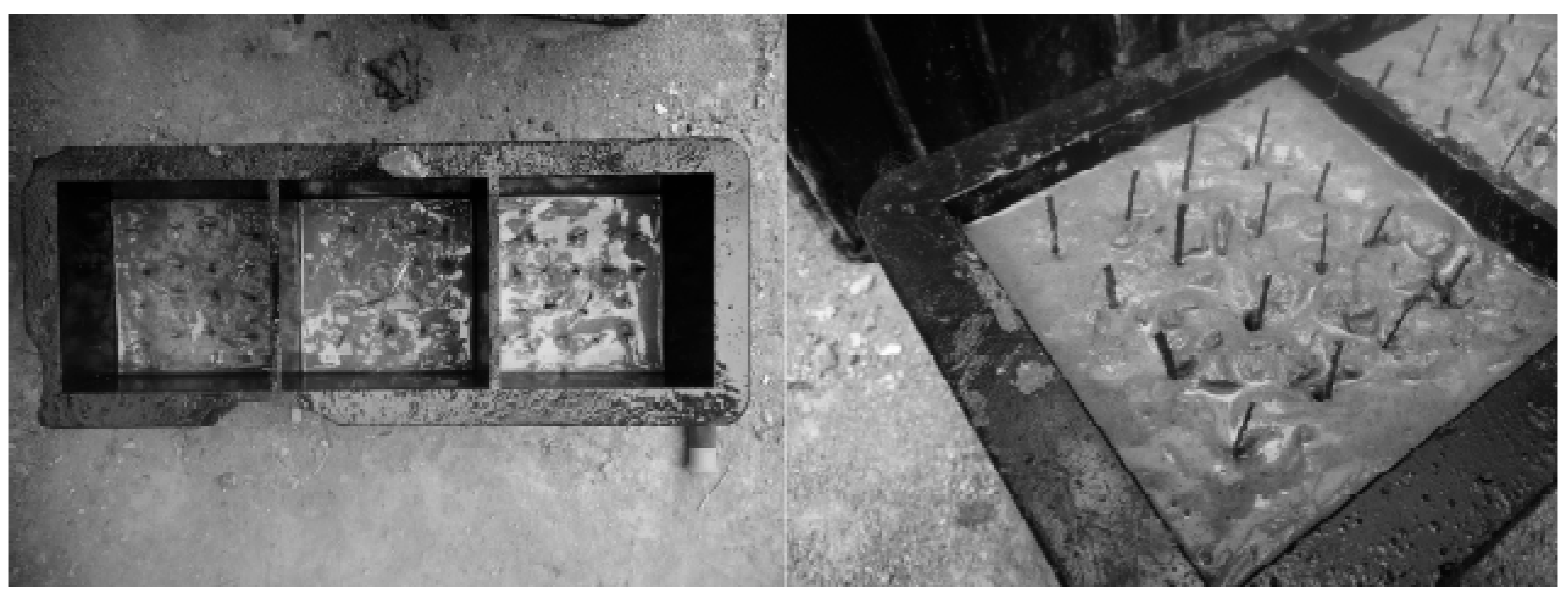

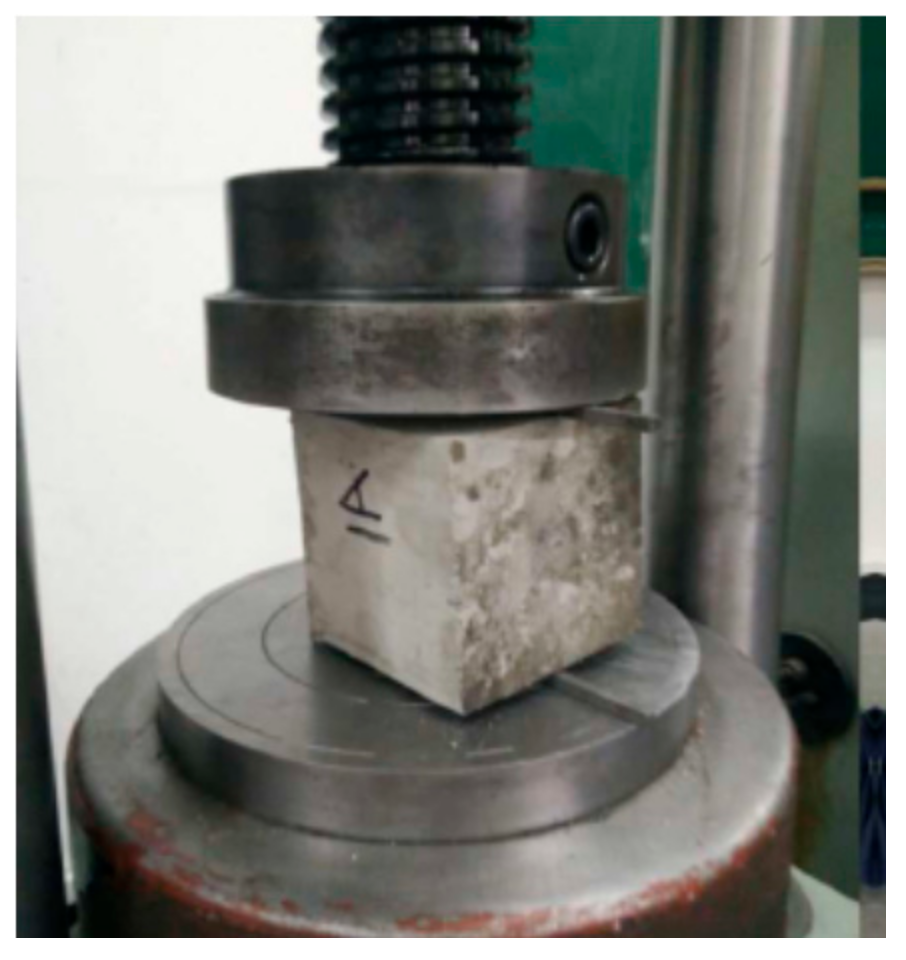


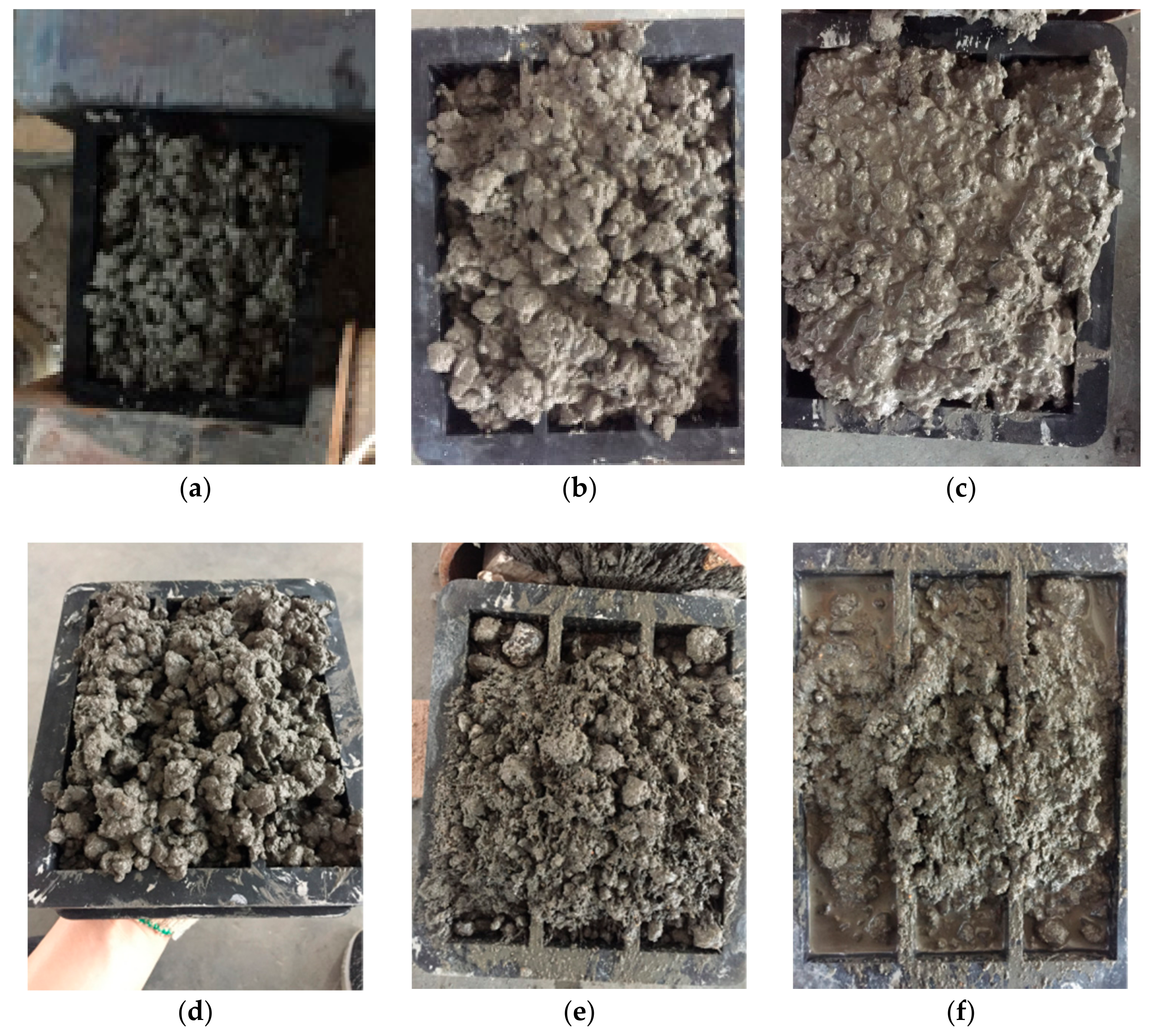
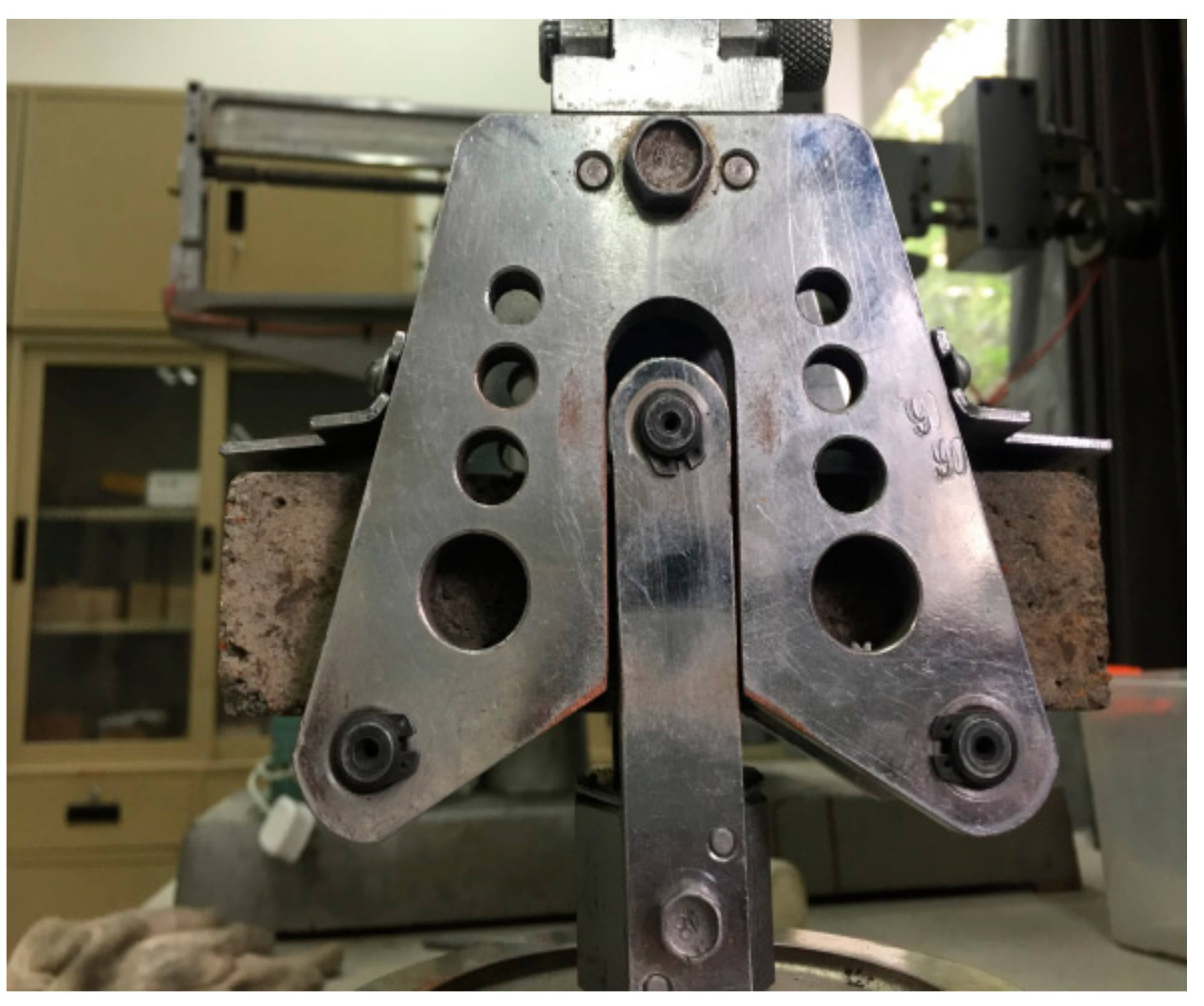
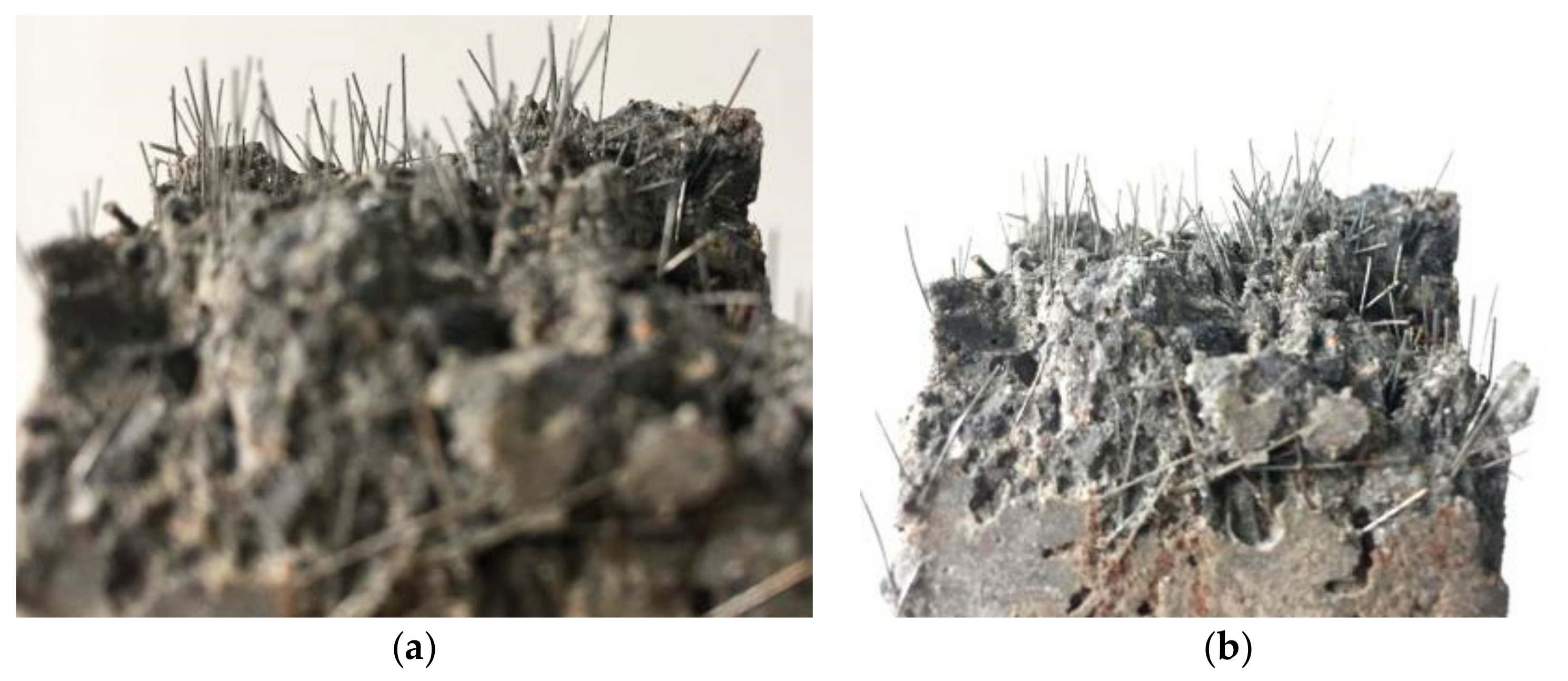

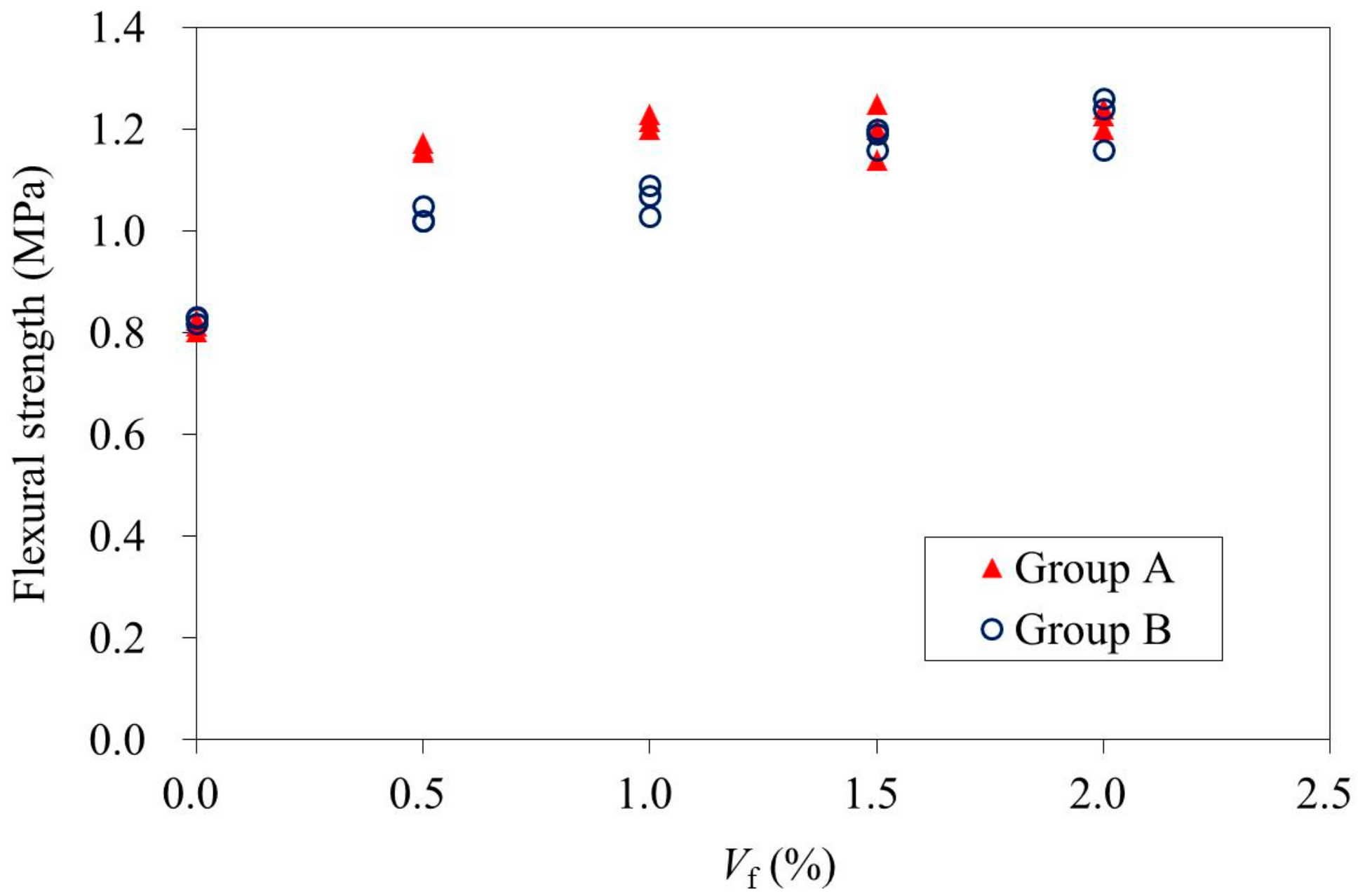
| Content | Water | Sand | Cement | River Stone/Steel Slag |
|---|---|---|---|---|
| Weight | 480 | 144 | 730 | 1096 |
| Size (mm) | <2.36 | 2.36 | 4.75 | 9.5 | 16 | 19 | 26.5 | 31.5 |
|---|---|---|---|---|---|---|---|---|
| Retained (%) | 99.8 | 96.3 | 94.0 | 86.8 | 59.2 | 29.0 | 3.6 | 0 |
| Specimen | 7 Days | 28 Days | ||
|---|---|---|---|---|
| F (kN) | fts (MPa) | F (kN) | fts (MPa) | |
| NC-S1 | 42.9 | 2.34 | 47.8 | 2.61 |
| NC-S2 | 41.9 | 2.29 | 46.9 | 2.56 |
| NC-S3 | 42.3 | 2.31 | 47.1 | 2.57 |
| NC-S4 | 42.9 | 2.34 | 48.4 | 2.64 |
| NC-S5 | 41.6 | 2.27 | 46.7 | 2.55 |
| NC-S6 | 43.1 | 2.35 | 47.4 | 2.59 |
| Mean | 42.5 | 2.32 | 47.4 | 2.59 |
| Specimen | 7 Days | 28 Days | ||
|---|---|---|---|---|
| F (kN) | fts (MPa) | F (kN) | fts (MPa) | |
| NC-M1 | 41.2 | 2.25 | 45.6 | 2.49 |
| NC-M2 | 40.5 | 2.21 | 45.2 | 2.47 |
| NC-M3 | 41.4 | 2.26 | 46.0 | 2.51 |
| NC-M4 | 41.5 | 2.27 | 44.7 | 2.44 |
| NC-M5 | 40.1 | 2.19 | 45.4 | 2.48 |
| NC-M6 | 41.0 | 2.24 | 45.6 | 2.49 |
| Mean | 40.9 | 2.24 | 45.4 | 2.48 |
| Specimen | 7 Days | 28 Days | ||
|---|---|---|---|---|
| F (kN) | fts (MPa) | F (kN) | F (kN) | |
| MDC-S1 | 45.4 | 2.48 | 49.4 | 2.70 |
| MDC-S2 | 45.2 | 2.47 | 50.1 | 2.74 |
| MDC-S3 | 46.2 | 2.52 | 50.0 | 2.73 |
| MDC-S4 | 45.1 | 2.46 | 49.6 | 2.71 |
| MDC-S5 | 45.6 | 2.49 | 49.3 | 2.70 |
| MDC-S6 | 45.2 | 2.47 | 50.4 | 2.75 |
| Mean | 45.5 | 2.48 | 49.8 | 2.72 |
| Specimen | 7 Days | 28 Days | ||
|---|---|---|---|---|
| F (kN) | fts (MPa) | F (kN) | fts (MPa) | |
| MDC-M1 | 44.1 | 2.41 | 47.1 | 2.57 |
| MDC-M2 | 43.7 | 2.39 | 46.7 | 2.55 |
| MDC-M3 | 43.6 | 2.38 | 47.3 | 2.58 |
| MDC-M4 | 44.3 | 2.42 | 46.9 | 2.56 |
| MDC-M5 | 44.5 | 2.43 | 47.2 | 2.57 |
| MDC-M6 | 44.0 | 2.40 | 46.8 | 2.56 |
| Mean | 44.0 | 2.41 | 47.0 | 2.57 |
| Series | Water | Cement | Sand | Steel Slag | Iron Sand |
|---|---|---|---|---|---|
| A | 178 | 310 | 764 | 1013 | 0 |
| B | 145 | 310 | 545 | 1013 | 0 |
| C | 138 | 310 | 434 | 1013 | 0 |
| D | 135 | 310 | 253 | 1013 | 0 |
| E | 193 | 310 | 382 | 1013 | 1670 |
| F | 185 | 310 | 556 | 1013 | 912 |
| Test Specimen | Vf (%) | Vibration Method | |
|---|---|---|---|
| Group A | S0-M1 | 0 | Magnetic method |
| S0-M2 | 0 | Magnetic method | |
| S0-M3 | 0 | Magnetic method | |
| S0.5-M1 | 0.5 | Magnetic method | |
| S0.5-M2 | 0.5 | Magnetic method | |
| S0.5-M3 | 0.5 | Magnetic method | |
| S1-M1 | 1.0 | Magnetic method | |
| S1-M2 | 1.0 | Magnetic method | |
| S1-M3 | 1.0 | Magnetic method | |
| S1.5-M1 | 1.5 | Magnetic method | |
| S1.5-M2 | 1.5 | Magnetic method | |
| S1.5-M3 | 1.5 | Magnetic method | |
| S2-M1 | 2.0 | Magnetic method | |
| S2-M2 | 2.0 | Magnetic method | |
| S2-M3 | 2.0 | Magnetic method | |
| Group B | S0-S1 | 0 | Shaking table |
| S0-S2 | 0 | Shaking table | |
| S0-S3 | 0 | Shaking table | |
| S0.5-S1 | 0.5 | Shaking table | |
| S0.5-S2 | 0.5 | Shaking table | |
| S0.5-S3 | 0.5 | Shaking table | |
| S1-S1 | 1.0 | Shaking table | |
| S1-S2 | 1.0 | Shaking table | |
| S1-S3 | 1.0 | Shaking table | |
| S1.5-S1 | 1.5 | Shaking table | |
| S1.5-S2 | 1.5 | Shaking table | |
| S1.5-S3 | 1.5 | Shaking table | |
| S2-S1 | 2.0 | Shaking table | |
| S2-S2 | 2.0 | Shaking table | |
| S2-S3 | 2.0 | Shaking table | |
| Group A | Group B | ||||||||
|---|---|---|---|---|---|---|---|---|---|
| Specimen | 0–15° | 15°–45° | 45°–75° | 75°–90° | Specimen | 0–15° | 15°–45° | 45°–75° | 75°–90° |
| S0.5-M1 | 177 | 58 | 31 | 15 | S0.5-S1 | 68 | 80 | 53 | 56 |
| S1.0-M1 | 307 | 73 | 48 | 34 | S1.0-S1 | 85 | 88 | 99 | 80 |
| S1.5-M1 | 368 | 84 | 64 | 42 | S1.5-S1 | 117 | 138 | 122 | 100 |
| S2.0-M1 | 468 | 96 | 80 | 54 | S2.0-S1 | 165 | 188 | 133 | 142 |
© 2018 by the authors. Licensee MDPI, Basel, Switzerland. This article is an open access article distributed under the terms and conditions of the Creative Commons Attribution (CC BY) license (http://creativecommons.org/licenses/by/4.0/).
Share and Cite
Xue, W.; Chen, J.; Xie, F.; Feng, B. Orientation of Steel Fibers in Magnetically Driven Concrete and Mortar. Materials 2018, 11, 170. https://doi.org/10.3390/ma11010170
Xue W, Chen J, Xie F, Feng B. Orientation of Steel Fibers in Magnetically Driven Concrete and Mortar. Materials. 2018; 11(1):170. https://doi.org/10.3390/ma11010170
Chicago/Turabian StyleXue, Wen, Ju Chen, Fang Xie, and Bing Feng. 2018. "Orientation of Steel Fibers in Magnetically Driven Concrete and Mortar" Materials 11, no. 1: 170. https://doi.org/10.3390/ma11010170




